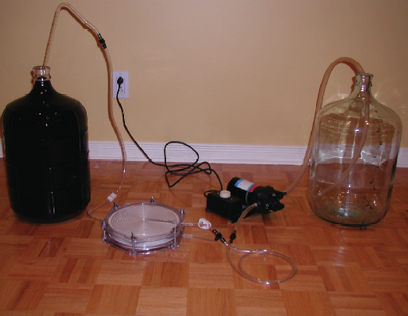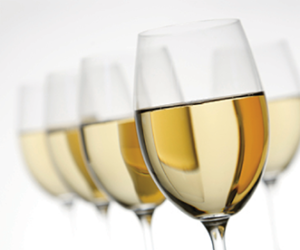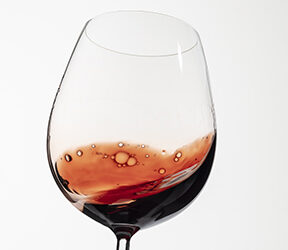Q
I make a Cabernet/Merlot blend, 92-8%. I filter with a 2-micron filter before bottling and let it age three to four months or longer, but I have fine sediment in my bottles. What do I need to do to correct this problem?
John Cernac
Pueblo, Colorado
A
The fun of filtration! I’ll deliver the bad news to you and my readers first by telling you that really no matter how tight of a pore size you use to filter your wines, there is always the possibility of sediment developing over time. In fact, with red wines, it’s actually just about guaranteed.
You see, a lot of sediment we find in wines actually forms after the wine is bottled, and is nothing that filtration can control. Even if we pass the wine through a nominally “sterile” small pore filter size of 0.45 micron (through which the smallest bacteria cells cannot pass), over time phenolic substances can condense and fall out of solution, as may organic acids and other components. These all accumulate at the bottom of the bottle (or on the side, if that’s how you have it stored) as a fine sediment. In white wines, this is typically seen as the fine crystals of potassium tartrate, unless the wine was intentionally cold stabilized (chilled to force crystal formation and then filtered to remove the crystals) before bottling. Red wines tend to throw more sediment simply because they are not cold stabilized and because they have more “stuff” (tannins, colored components, etc.) to condense into larger molecules and fall out of solution. As a winemaking professor of mine used to quote in bumper sticker speak, “Sediment Happens.”
In your case, however, I would guess that you might have had a microbial interloper or four in your bottles. A 2-micron filter is tight enough to exclude yeast but will allow bacteria to pass through. There are many bacteria in the wine world that can survive very happily in a bottle’s low-oxygen environment. As they go about their merry metabolism business, especially if you had any residual sugar or malic acid in your wine, they can throw out a heck of a lot of sediment.
Similarly, 2-micron filters will take out very large particles of “crud” that may be in your wine and the liquid may look relatively clear, but you’d be surprised how much very fine sediment might be getting through. You lay those bottles down for a few months and, bam! You’ve essentially done another good settling and need to rack again — except this time the wine is already bottled! Why not make sure that your wine is good and settled and leave it in your barrel (or carboy) for another month or two before filtering and bottling?
And just to make sure you’re not getting extra sediment when doing the roughest rack, you might consider doing a “double racking” pre-bottling. This is essentially doing the initial rack of gross lees, and then allowing the racked wine to rest in its holding vessel for at least another week before filtering. This allows the sediment kicked up by the initial rack (and there most probably will be some) to drop to the bottom of the vessel. Filtering off of gross lees is tough, and you’ll probably suck up a lot of fine sediment that way and may even clog your 2-micron filter in the process.
It’s also possible your red blend threw some sediment because the polyphenolic components and tannins just weren’t condensed and “together” enough before you bottled it. I always say that when you bottle a wine, what you get is what you get and you’ve essentially closed the door on the wine’s development. Big, tannic reds typically need more time than whites or lighter reds before they’re bottled because of their high polyphenolic load. The stuff that gives red wines its “guts” will, to an extent, continue to polymerize into larger and larger molecules and typically needs about 16-20 months to do so. The industry standard for a big Cabernet is around 18 months in barrel.
My best advice? If you’re going to go to the trouble of filtering, spring for the 0.45-micron filter and exclude all the little buggies that would want to munch on your wine. Only go to bottle after making sure you’ve let the wine settle out and bulk-age long enough to drop most of its readily formed sediment. Additionally, be sure you are not kicking up a lot of sediment as you rack and prep to go to bottle. Sometimes a red wine will look clear to the eye when it’s really not.
Q
I’ve been a subscriber for many years and have had a vineyard for over 20 years. Historically, I have harvested my Leon Millot on Labor Day weekend with Brix between 25 and 26 and pH of 3.4 to 3.5. This year my sugar is above 24 but my pH is barely above 3 (3.06). My seeds are brown and do not taste harsh. My question is, would you go ahead and harvest now or would you hold out for a better pH and run the risk of Brix in the 27 to 29 range? Do you have any history of such of a dilemma? Thanks for any insight that might be sent my way.
Jack Kerr
Santa Fe, New Mexico
A
That is indeed a situation I face every year and is part of the delicate dance of being a winemaker. As many of my readers know, I believe that picking is the single most important decision you will ever make in a wine’s life. Once you do that, the road to what that wine can and will be is set before you. I find that pH, acidity and flavor are a much bigger prediction of “ripeness” than Brix levels or seed browning. Sugar accumulation can fluctuate wildly year-to-year and may be impacted by dehydration in the vineyard, especially as the end of harvest approaches. Some varietals get browner seeds than others and I do find year-to-year variation there too.
That low pH is a little bit of a weird factor. First, I would re-check your pH analysis because everything else seems to be in alignment. If you truly have a pH that low, does the acid taste that high? Are there any green flavors? If so, then I would wait a little bit longer. I am much more comfortable letting the Brix get a little higher and adding water (which will also raise the pH), than running the risk of picking something that is still really “green” and unripe by flavor. Similarly, from a winemaking quality point of view, I always prefer to water back Brix than to de-acidify juice. I find adding potassium or calcium carbonate to a wine really changes the aroma and flavor, whereas simply hydrating a bit is a much more natural step.
So I would double-check your pH number, be sure you are picking something that tastes “ripe” to you and that you are using all of your senses to help guide you in the decision. In a “weird” pick situation, never rely on just one number or indicator, which might be a strange outlier just for that year.
Q
I recently moved from Ohio to Arizona and need to move my homemade wine. I have bottles in cases and 40+ gallons (150+ L) in 5-gallon (19-L) carboys. It will need temperature controlled shipping. I found a couple of transporters that specialize in wine transporting but are more for high end collections and are very expensive. As a home winemaker without a license, what options are out there?
Bill LoPresti
Fountain Hills, Arizona
A
When moving wine, the main thing to be concerned about is temperature change and since you’ve got carboys, spillage! For the first factor, any kind of moving truck where the back payload is not air-conditioned is an absolute no-go. Interior cargo temperatures can really swing wildly, especially depending on the time of year you move, and you want to make sure you are in complete control of the environment your wine gets shipped through. For this reason, using your buddy’s pickup truck is also a no-no.
Though you don’t mention the size of your cased wine collection, why not something like a U-Haul cargo van rental? The entire unit is enclosed and therefore the climate can be controlled. The vans are white which will provide extra help in controlling your temperature. Often times the floor is customizable and bench seats can be removed and inserted according to your needs.
To address the possibility of spilling your carboys — make sure that you are not transporting actively fermenting juice or must. Any kind of motion, exacerbated by a rise in temperature, can set off a fizzy carbon dioxide chain reaction of blown tops! If you are not fermenting and are all sulfured and buttoned up, your risks of spillage are a lot less. You need to make sure that the carboy tops are totally secured. Can you tape down your bungs really tightly? Even better would be to transport in kegs that have a metal clamp fitting on top. That way the tops are guaranteed to stay on and you’re not worried about breaking glass. If your carboys are glass, you need to guard against breakage. I would put a big sheet of plastic down in the van and at the very least wrap the carboys in towels or old blankets so they don’t jostle against each other or the sides of the van.
However you transport, do it gently and do it quickly. Like dogs or houseplants, don’t ever leave wine in a hot car with the AC turned off! Drive with a buddy so one of you can be in the van while the other goes and grabs coffee or takes a bathroom break. Try to avoid potholes and good luck!
However you transport, do it gently and do it quickly. Like dogs or houseplants, don’t ever leave wine in a hot car with the AC turned off!
Q
I have been making red wine from fresh grapes for a number of years, but this is my first year in which I have crushed and de-stemmed 400 pounds of Pinot Noir. These grapes came from California, and I crushed them on September 14th. After crushing, I used potassium metabisulfite to stun the wild yeast and used RC-212 to start the primary fermentation after testing the pH, acid, and Brix (24.5). The primary fermentation is moving along as it should, but the must color has me concerned. I expected to have a light red color, but I have a light brown color. What is the likely cause, and will the color change after skin exposure? Thanks for your help.
Joe Koterba
North Eastham, Massachusetts
A
I had this exact problem happen to me this year with one of my lots of Russian River Pinot. Thankfully, the original brick-red color disappeared and was replaced by bright red once the fermentation got going and the wine got back into a reductive carbon dioxide-rich environment and after a few day’s skin exposure. On this lot, I also used Colorpro fermentation enzyme from Scott Laboratories to help extract color from the skins. After pressing, the red color has stayed and I expect the wine to look fine. Some would say, “Welcome to the World of Pinot!”
As you may be aware, Pinot Noir is a naturally color-poor varietal. Additionally, the colored compounds tend to be more of the red spectrum rather than blue-purple. For this reason, when we make Pinot, we have to, first of all, be patient and manage our expectations; there’s no way a Pinot Noir will ever look like a Petite Sirah. We also need to do some additional things, like perhaps use a fermentative enzyme and definitely be careful of oxygen exposure after fermentation in order to preserve color.
Indeed, a newly destemmed Pinot Noir fermentation can appear almost like muddy-pink water the first couple of days and can definitely alarm those not accustomed to it. As the fermentation gets going it will begin to look more like real “wine” as oxygen levels go down (oxygen can brown delicate Pinot Noir pigments) and more skin components start extracting. It sounds like you’ve done the right things, including adding potassium metabisulfite, but I would check your pH and maybe add a little acid if it’s above 3.60. Wine color is pH sensitive and you’ll have better color retention and appearance if your pH is not too high. Pinot Noir doesn’t lend itself to extended maceration.
In fact, an Australian study showed that wine pigments can actually re-absorb back onto the grape skin matrix over time so be sure to press off within a day or three of dryness. Be sure to protect your new wine from oxygen, adjust the acidity if necessary (keep finished post-ML fermentation wine pH below 3.75) and store with FSO2 levels 25-32 parts per million. Try adding your sulfur dioxide in two doses when you adjust. Sometimes giving Pinot Noir a big hit all at once can actually bleach color.
Indeed, “Welcome to the World of Pinot!”
Related Links:
• To learn more about making Pinot Noir, check out Chik Brenneman’s “Varietal Focus” column on the grape from the Burgundy region in the December 2012-January 2013 issue of WineMaker magazine at http://winemakermag.com/story1227
• Want to know more about filtering? Read Daniel Pambianchi’s “Techniques” column from the Winter 2000 issue of WineMaker magazine “Choosing a Filtering System” at







